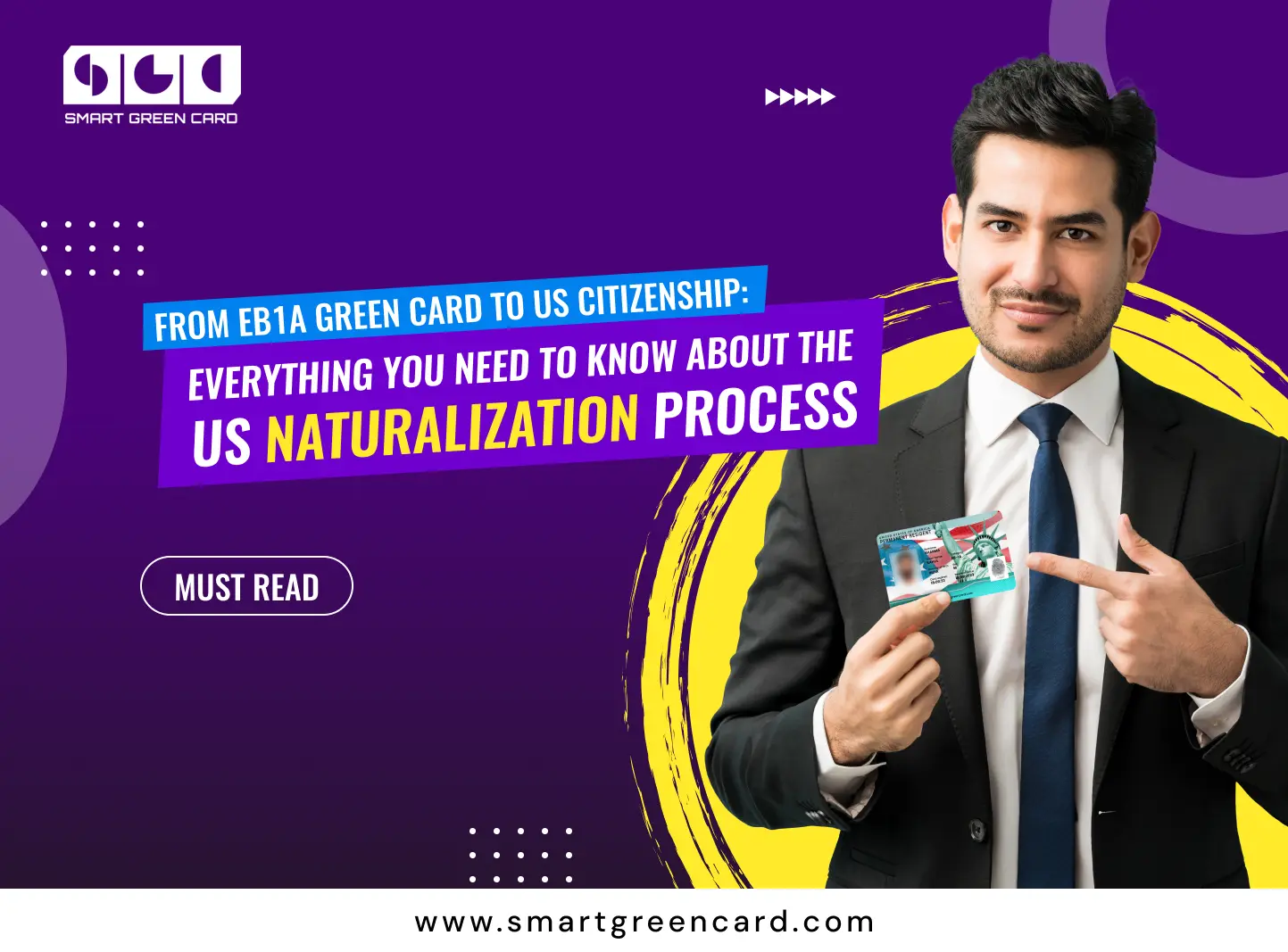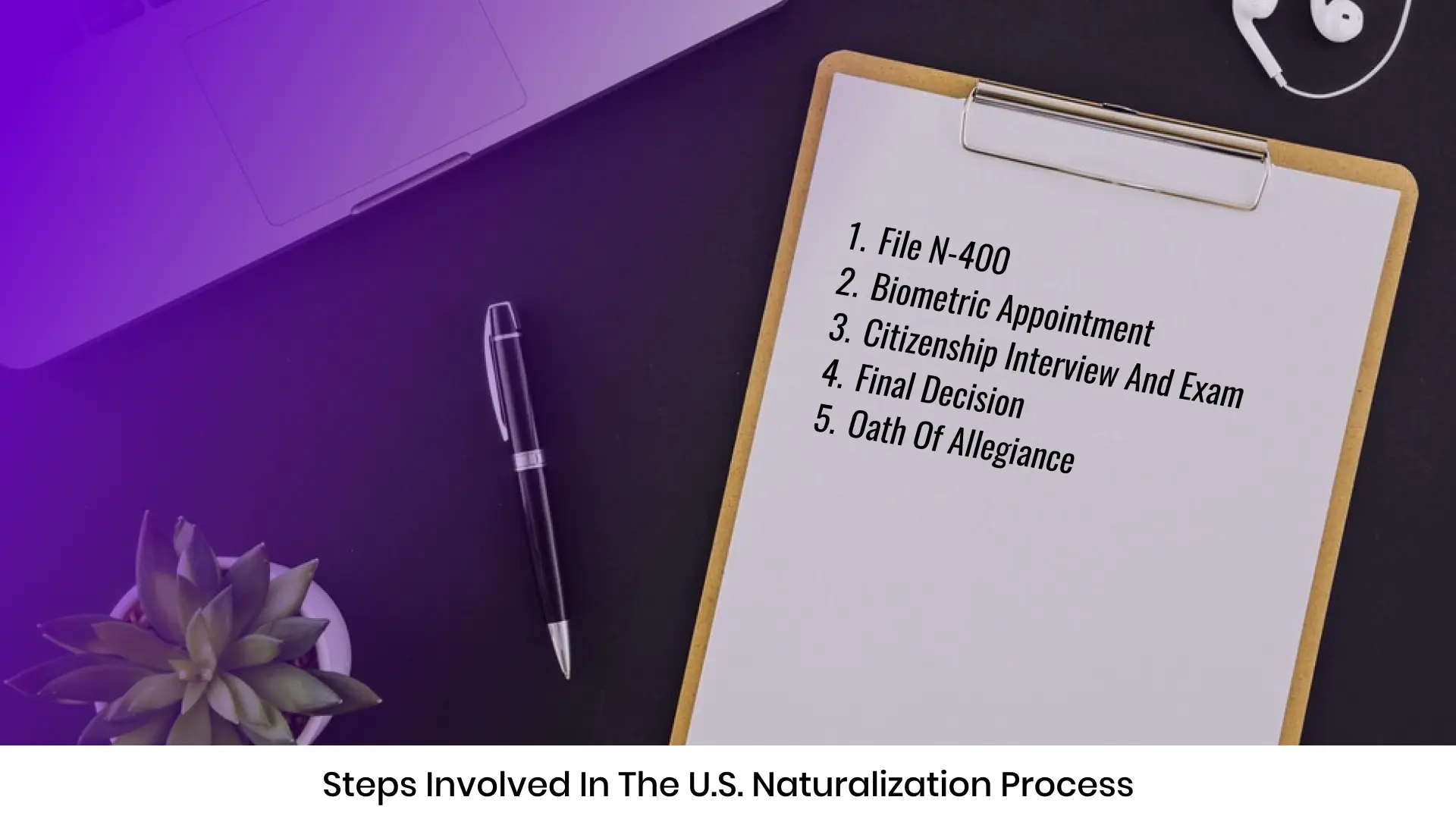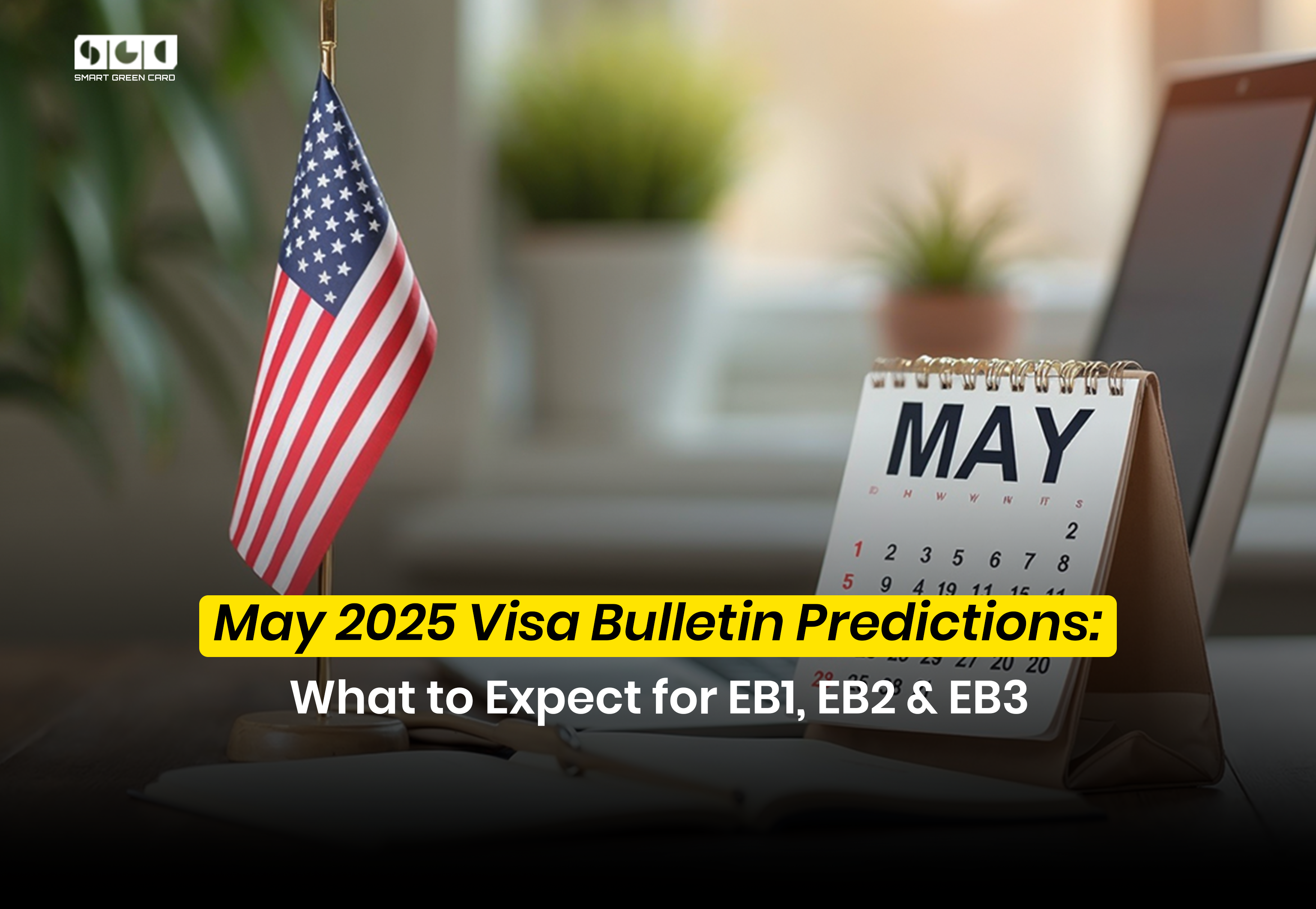From EB1A Green Card to US Citizenship: Everything You Need to Know About the US Naturalization Process

If you are curious about the next immigration step after the EB1A Green Card, particularly when you want to permanently reside in the U.S. and enjoy benefits similar to those of a U.S. citizen, in that case, you need to undergo the naturalization process.
Through the U.S. naturalization process, individuals who are lawful permanent residents in the U.S. can acquire U.S. citizenship by meeting the requirements outlined in the Immigration and Nationality Act (INA), as set by Congress.
In this blog, we have provided a detailed explanation of the eligibility requirements and process for US naturalization. Additionally, we have highlighted the benefits and responsibilities associated with US citizenship. Let’s get started.
When Can You Apply for U.S. Citizenship?

You need to submit Form N-400, an Application of Naturalization, to obtain U.S. citizenship. Here are two ways you can apply after your EB1A green card:
- You need to wait for five years after receiving your EB1A green card and meet the eligibility requirements of the naturalization process to apply for U.S. citizenship.
- On the other hand, if you are married to a U.S. citizen after receiving your green card, you can apply for U.S. citizenship after three years. This rule is applicable when you receive your green card through an employer sponsor or self-petition, not from the marriage pathway.
Moreover, you can also submit a U.S. naturalization application 90 days before the completion of a five or three-year period of being a permanent resident.
Eligibility Requirements for the U.S. Naturalization Process
After five years of being a permanent resident, there are specific requirements that you must fulfill to proceed with the naturalization process:
1. You need to be at least 18 years of age to apply for Form N-400.
2. Being a lawful permanent resident and maintaining continuous residence in the U.S. for at least five years before applying for Form N-400 is necessary.
That being said, you can only stay outside the U.S. for up to six months; otherwise, it breaks the continuity.
3. Additionally, it’s necessary to demonstrate a physical presence in the U.S. for at least 30 months out of the five-year period.
4. It is necessary to demonstrate a minimum of 30 months of physical presence in the U.S. and residency in a state or USCIS authorization district for at least three months.
5. Demonstrate that you have been a good moral character for five years right before the date of filing N-400 application
6. You must be able to write, read, and speak basic English, and you should know the history of America and the principles of the U.S. government to apply for U.S. naturalization.
7. Showcase your commitment to the principles and ideals outlined in the U.S. Constitution.
8. Be willing to take an oath of allegiance to the U.S., which means stating that you are loyal and follow the laws of the country.
Supporting Documents Required for the U.S. Naturalization Process
Here is a basic checklist of evidence you need to submit along with your U.S. Naturalization application:
1. Provide a Photocopy of the front and back portion of your Green Card.
2. Two Passport-size photographs for identification only when you are applying for Form N-400 from outside the U.S.
3. Your fee payment application.
4. Fee waiver or Fee reduction application ( if applicable).
5. If you would like to have an attorney or representative during your U.S. citizenship interview, you need to submit Form G-28, Notice of Entry of Appearance as Attorney or Accredited Representative, along with a Naturalization application
6. Photocopy of your marriage certificate(if applicable)
Apart from these proofs, you need to bring several supporting documents at the time of your U.S. Naturalization interview.
Here is a basic list of documents; however, it is recommended to check the N-400 instructions for the required documents along with your interview appointment letter:
1. Your EB1A Green Card
2. Your State ID and Driver’s license
3. Your current and expired passport, Form I-94 arrival/departure record
4. Your Marriage certificate(if applicable)
5. Evidence of your official name changes(if applicable)
Filing Location and Filing Fee of Form N-400
You can file Form N-400 either online using your USCIS online account or by mail at the address mentioned in the Direct filing address for the Form N-400 page.
The current filing fee for the N-400 application, along with the biometric fee, is $725; however, according to USCIS’s new proposal, the fee is likely to increase to $760.
Understanding the Responsibilities of US Citizenship
Applying for U.S. naturalization after obtaining a green card depends on your preferences. However, it is crucial to understand the basic duties of a U.S. citizen to make an informed decision.
1. The Indian constitution doesn’t allow dual citizenship status, which means you need to give up Indian citizenship before getting U.S. citizenship. However, the U.S. allows dual citizenship.
Moreover, the Government of India introduced an overseas citizenship India card.
By obtaining this card, you can enjoy certain benefits like NRI, such as buying and selling immovable properties except for agricultural and plantation land, a life-long visa, and having an Indian bank account, etc.
2. If you acquired U.S. citizenship, you need to file income tax returns to the U.S., even when you are living outside the U.S.
However, you have certain exclusions and benefits when you meet certain requirements that eliminate or reduce your tax duty.
3. If you are a male green card holder between the ages of 18 and 26, you must register with a selective service system; failure to register may cause ineligibility for the U.S. naturalization process.
The Selective Service system, an independent agency of the US government, maintains records of individual information for military service during a national emergency.
However, the compulsory military service requirement, known as the draft, was discontinued in 1973. If the draft were reinstated, individuals would be required to perform military service when called upon.
4. Serving on jury duty is mandatory as a U.S. citizen when called upon.
Steps Involved in the U.S. Naturalization Process

Here are the steps involved in transitioning from an EB1A green card to obtaining US citizenship.
1. File N-400, Application for Naturalization
Once you are eligible for the requirements of the naturalization application, you need to fill out Form N-400 with supporting documents. As previously stated, you can send the Form N-400 by mail or through USCIS online account.
2. Biometric Appointment
In about one month, you will receive I-797 C (Notice of Action), which contains the location and time of your biometric appointment
At the time of a Biometric appointment, you need to provide your photographs, fingerprints, and signature for background and security checks.
Make sure you bring the necessary documents during your biometric appointment, as requested, to avoid processing delays.
A bio-metric appointment is crucial; if you fail to attend after you receive your appointment notice without proper rescheduling, USCIS may deny your application.
3. Citizenship Interview and Exam
Usually, within 14 months after USCIS gets your Form N-400, you will get an appointment letter containing the date and location of the interview. In the letter, they also list the documents you need to bring to your interview.
In general, the U.S. Naturalization interview is to confirm that the information provided in your application is true.
U.S. Naturalization Test:
On the same day of the interview, USCIS conducts English and civics tests. They will announce the result of your interview and test at the end of the interview.
However, certain individuals are exempt from English tests based on their age and the length of time they stay as lawful permanent residents in the U.S., but they need to take civic tests on their language choice.
Furthermore, persons with long-term physical or mental disability are exempted from the English and civics tests.
4. Final decision
USCIS will make the final decision on your application on the day of the interview, or you should wait 120 days to get your result.
The final decision will be approval or denial or continuation of your U.S. naturalization application.
If USCIS needs additional information or you failed the exam, USCIS will continue your application and schedule a second interview within 60-90 days after the first interview.
In the second interview, you have a chance to retake the failed part of an exam or submit the required additional documents as per your case.
5. Oath of Allegiance
The Oath of Allegiance is the final step to becoming a naturalized U.S. citizen when your N-400 is approved. Oath of allegiance may happen on the same day of the interview if your U.S. Naturalization application is approved.
Otherwise, after your Form N-400 approval, USCIS will send you a Form-445, Notice of Naturalization Oath Ceremony, that contains the date and location of the oath ceremony.
Once you take an Oath of Allegiance, you will get a certificate of naturalization; if you fail to participate in this oath ceremony more than one time, it may lead to an application denial.
Conclusion
Once you get the approval of Form N-400, Application of Naturalization, and complete the oath of allegiance, you will officially become a U.S. citizen.
So, here are certain benefits you get when you are a U.S. citizen:
- You can get a U.S. passport, which allows you to travel to 180 destinations without a visa.
- You can sponsor green cards for parents, adult children, siblings, etc.
- Your children under the age of 18 automatically qualify as U.S. citizens.
- You are eligible to vote and contest in elections
- You are eligible to apply for federal jobs.
On the other hand, an EB1A green card holder is allowed to sponsor your spouse and unmarried children under the age of 21 to get their green cards.
You can be eligible to apply for certain government jobs, are legally protected under U.S. laws, and be a volunteer or financial contributor in the election.
Moreover. as a permanent resident, you need not renounce your Indian citizenship.
However, Choosing the U.S. Naturalization process after a Green Card depends on your needs, but a Permanent residency is essential when you want to stay and work in the U.S. indefinitely and travel outside the U.S. without any travel restrictions.
If you are looking for a U.S. green card in a reasonable time, an EB1A green card might be your choice, as the final action dates for EB1 green cards are faster than those for EB2 and EB3 green cards.
To understand the requirements for an EB1A green card and to receive hands-on guidance for building your EB1A profile, check out our Smart Green Card VIP plan.
Ready to take control of your immigration journey? Find personalized support and expert insights at Smart Green Card.
- SGC
- No Comments
Latest blog & Newsletters
May 2025 Visa Bulletin Predictions: What to Expect for EB1, EB2 & EB3
May 2025 Visa Bulletin Predictions: What to Expect for EB1, EB2 & EB3...
Smart Green Card: Expert Guidance for Your U.S. Visa & Green Card Journey
Smart Green Card: Expert Guidance for Your U.S. Visa & Green Card Journey...
H1B Lottery Results 2025: Everything You Need to Know
H1B Lottery Results 2025: Everything You Need to Know The H1B visa lottery...





